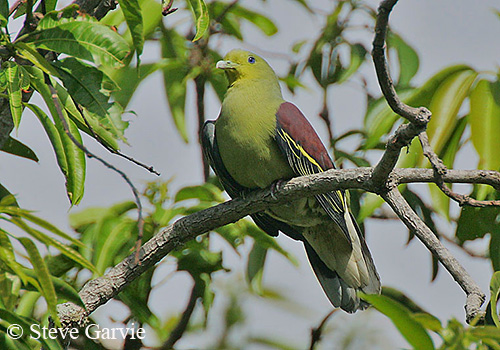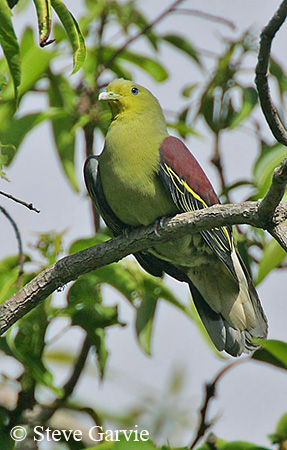
Fr: Colombar pompadour
Ang: Sri Lanka Green-pigeon - Pompadour Green-Pigeon
All: Ceylongrüntaube
Esp: Vinago de Ceilán
Ita: Piccione verde della Pompadour
Nd: Ceylonpapegaaiduif
Sd: ceylongrönduva
Photographers:
Steve Garvie
RAINBIRDER Photo galleries
Alan & Ann Tate
AA Bird Photography
Text by Nicole Bouglouan
Sources:
HANDBOOK OF THE BIRDS OF THE WORLD vol 4 by Josep del Hoyo-Andrew Elliott-Jordi Sargatal - Lynx Edicions - ISBN: 8487334229
PIGEONS AND DOVES by David Gibbs, Eustace Barnes and John Cox - Pica Press Sussex - ISBN: 1873403607
Bird Watching Tour in Sri Lanka
Wikipedia, the free encyclopaedia
Sri Lanka Green-pigeon
Treron pompadora
Columbiformes Order – Columbidae Family
INTRODUCTION:
The Sri Lanka Green-pigeon is endemic to Sri Lanka where it frequents forests and woodlands, and other types of open areas with trees, up to 1,000 metres of elevation.
It feeds on small fruits from various plant species. This species often feeds in groups at abundant food sources and takes part in seed dispersion.
As usual in the family Columbidae, the Sri Lanka Green-pigeon builds a stick nest in tree. Both adults share the nesting duties.
This species is known for its ability to blend into the dense foliage of the forest canopy, thanks to its beautiful green plumage, as usual in the genus Treron.
The Sri Lanka Green-pigeon is described as fairly common and locally abundant. It is affected by habitat destruction and fragmentation, but it is not globally threatened at the moment.

DESCRIPTION OF THE BIRD:
Biometrics:
Length: M: 24-27 cm – F: 25,5-26,5 cm
The Sri Lanka Green-pigeon has green plumage varying in shade from individual to individual.
The adult male has dark purplish-chestnut mantle, scapulars and lesser wing-coverts. The rest of the upperwing is black with yellow edges to median and greater coverts and also secondaries. Rump and central tail feathers are yellowish olive-green. The outer rectrices are dark grey with olive tinged bases. They have a dark central band and a broad, pale grey terminal band.
On the underparts, breast and belly are pale soft green, to yellowish on lower belly. The lower flanks show dark and whitish spots. The undertail-coverts are whitish with greyish-green markings. The undertail is blackish with pale grey terminal band. On the underwing, the flight-feathers are grey and the coverts are yellowish-green.
On the head, forehead, face and throat are bright yellow-green. The hindneck is greyish-green and the crown is bluish-grey.
The bill is pale bluish-grey with greenish base.
The eyes are reddish-brown with green eye rims.
Legs and feet are reddish to purplish-red.
The adult female’s plumage pattern resembles male, but she has green plumage where the male is purplish-chestnut. She may appear slightly duller overall.
The juvenile resembles adult female but it is duller. It has a smaller yellow area on the throat. Hind crown and mantle are darker. On the upperwing, the tertials are greener, the wing-coverts show broader and more rounded yellow edges, and the primaries have more conspicuous white outer webs.
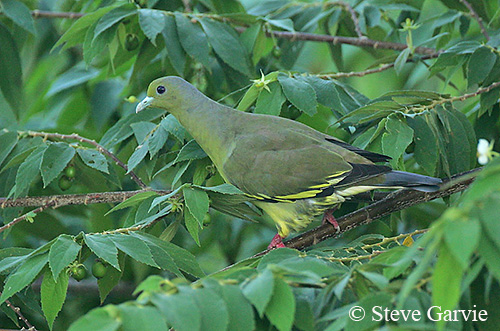
RANGE:
The Sri Lanka Green-pigeon is endemic to Sri Lanka. The species is present in all forest patches in the intermediate zone, and it is common in the national parks in the dry zone.
HABITAT:
The Sri Lanka Green-pigeon frequents the forests of the island, finding there both protection and food resources. It is known for hiding among the dense foliage, thanks to its green plumage.
It is resident in forested areas, but it also frequents open areas with tall trees and wooded agricultural fields. The species can be seen in lowlands and foothills, up to 1,000 metres of elevation.
CALLS AND SONGS: SOUNDS BY XENO-CANTO
The Sri Lanka Green-pigeon gives soft, mournful cooing sounds used to strengthen the pair bonds between the mates, and to communicate.
We can also hear series of short bursts of rapid clicking sounds, each being followed by short, downslurred dry croaks.
The song is a long, mellow, almost human-like whistle often heard in the forested areas. It includes 3-4 prolonged, low notes interspersed with 7-9 quick notes. The series ends abruptly on a stressed note. It may last 7-8 seconds, with 1-2 notes/second. There is a pause of several seconds between each series.
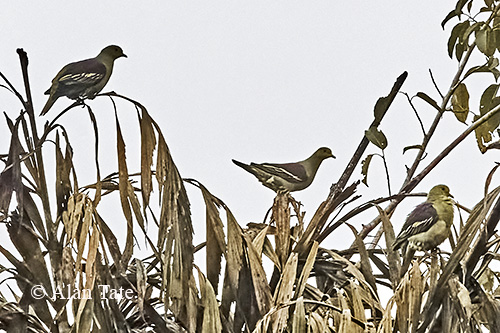
BEHAVIOUR IN THE WILD:
The Sri Lanka Green-pigeon feeds on fruits, flower buds, leaves and moss. The fruits of several plant species are consumed, and especially figs (Moraceae) plucked from trees, and Zyziphus (Rhamnaceae) which are the most usual fruits for this pigeon. But several others are also taken. It consumes these fruits by using biting food handling technique.
This species is typically arboreal and gregarious, at least seasonally. It is often observed in pairs or small groups of 12, but larger gathering of 200 or more individuals may occur at good fruiting trees. They can be seen at abundant food sources and at roosts. They communicate by soft, cooing calls. They also may engage in gentle preening that shows their affectionate nature. They are more active in the early morning and the evening while moving from feeding to roosting sites in fast, direct flight.
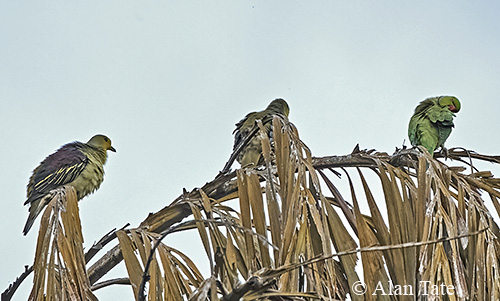
With a Rose-ringed Parakeet
on the right
While foraging, it frequently flies before to glean food at mid-level in trees, usually in foliage cover of moderate density.
It also drinks and forages on the ground for seeds and fruits (strawberries) which are the main part of the diet, but termites are also taken.
The Sri Lanka Green-pigeon plays an important role in seed dispersal throughout its forested habitat.
The courtship behaviour is not described. However, we can suggest that the rich purplish-chestnut male’s upperparts are enhanced, especially during the bowing displays.
The nest is a typical flimsy platform of twigs, built by both adults that share all the nesting duties. They are monogamous, at least for the season.
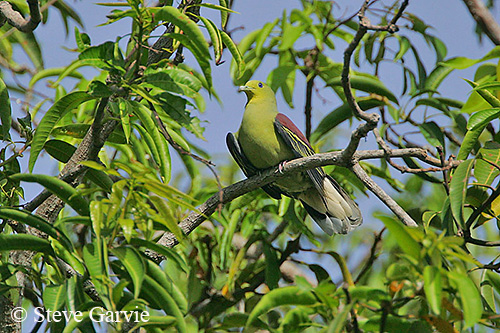
The Sri Lanka Green-pigeon is resident, but it may perform local and altitudinal movements, depending on food resources availability.
The flight of this species is strong, fast and direct, with quick, regular wingbeats and occasional sharp flicks of the wings, often observed in pigeons.
The bird performs swift, direct movements, but if alarmed, it may perform sharp twists and abrupt turns. When flushed, it may fly erratically while zigzagging.
REPRODUCTION OF THIS SPECIES:
The breeding season takes place from December to June.
The Sri Lanka Green-pigeon builds a flimsy platform made of interwoven sticks, within the branches of a tree, about 13 metres above the ground. Both adults build the nest.
The female lays two white eggs, and both parents incubate during 12-14 days. They also share other nesting duties such as chick-feeding and chick-rearing.
PROTECTION / THREATS / STATUS:
The Sri Lanka Green-pigeon is described as fairly common to locally abundant.
The species is threatened by destruction and fragmentation of the habitat. The size of the population is unknown, but it is suspected to be declining.
The Sri Lanka Green-pigeon is currently evaluated as Least Concern.
